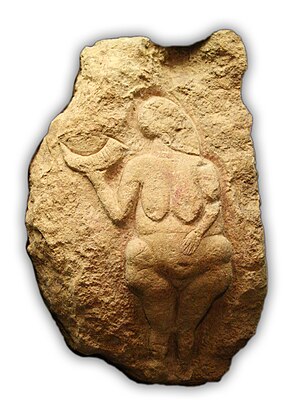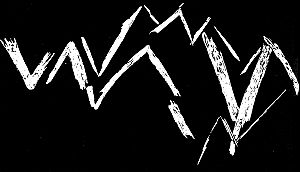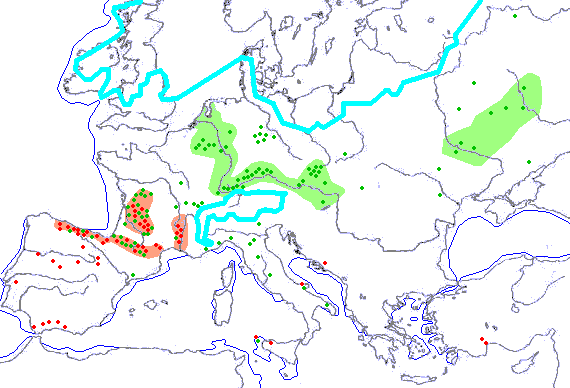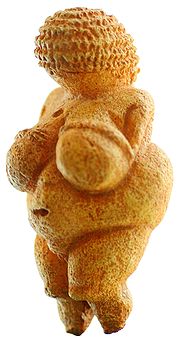Prehistoric Art: art in the Paleolithic , art of Upper Paleolithic , Media Art, Art parietal
Prehistoric Art

The Venus Laussel, one of the most famous palaeolithic Venus
If the first subtle signs of the prehistoric art dating from the late Middle Paleolithic, it takes a real scale until the early Upper Paleolithic (-30 000 to -12 000 years BC). It is so diverse in its themes, techniques and materials. It includes figurative animal, representations anthropomorphic often sketchy, and many signs.
In the Mesolithic (-12 000 to -8000 BC), the figurative arts events are rare. From this period are known pebbles painted or engraved with geometric figures.
In the Neolithic (-8000 to -3000 BC), the rock art is developing, including figurative elements, including pets. It is also expanding into new media, eg when scenery of ceramic pottery.
The emergence of art in the Paleolithic

Statement of the zigzag pattern etched on a bone found in the website Middle Palaeolithic from Bacho Kiro in Bulgaria

Block ocher with engraved geometric incisions, along with bifacial points and bone tools from the site of Blombos in South Africa, about 75 to 80 000 years BP
Some authors aesthetic concerns could arise from the Lower Paleolithic and this in several ways:
collection of natural objects
- a roller jaspillite red was found on a site frequented by australopithecines there are nearly 3 million years.
- a biface, dated 300 000 years and found at Swanscombe in England, has been shaped in a rock containing a fossil sea urchin.
- use of dyes: the use of hematite or 'tan is attested in various parts of the globe from 100 000 years.
- Using stones in remarkable production tools: jasper in Correze, rock crystal in different sites, obsidian during the Middle Paleolithic in Ethiopia ...
- manufacture of objects whose form has no obvious functional explanation:
- bolas, balls of stone and shaped more or less regular, obviously too heavy to serve as projectiles were found especially in Sidi Abderrhamane Morocco.
- Similarly, some authors consider the search for symmetry in the size of bifaces Acheulean as one of the first aesthetic concern.
However, it was not until the late Middle Paleolithic that the first incisions without functional role on bone or stone. In South Africa, the site of Blombos delivered stones engraved and colored geometric complex associated with ornaments shell. This discovery, dated more than 75 000 years BP, is one of the oldest forms of human artistic expression. It reflects the capacity of abstraction of Homo sapiens of the time.
Some sites Mousterian also comes unusual minerals or fossils collected by Neanderthals during their travels. These include the caves of Arcy-sur-Cure.
The art of Upper Paleolithic

Extension of art of Upper Paleolithic:
red dots: wall art
green dots: art furniture
Cyan line: limit of the main glaciers
blue line: coastline
The explosion of art forms is characteristic of the Upper Paleolithic. The Homo sapiens is the main player in this revolution, although researchers now believe that certain works can be attributed to the Neanderthals.
There are about 32 000 years, the art is already very diverse and successful, both in terms of thematic techniques. In the Chauvet Cave, one of the most ancient painted caves known, a large number of techniques (etching, painting, digital sketches, prints, etc..) Was used to make animal figures can be very realistic. At the same time, the statuettes in ivory are also known (see "Lion Man" of Hohlenstein-Stadel). No change from simple forms to more complex forms, is really noticeable. Although the art of Upper Paleolithic covers almost two thousand years, it is possible to identify a number of general features without going into detail about the chronology.
Media Art
The Upper Paleolithic art is in the form of cave paintings but also sculptures in clay, in stone, in ivory or bone. The works in wood, in tissues or other perishable materials have unfortunately disappeared. One can only imagine what they should be, and it is certain that our knowledge remains very incomplete.
The metal is not yet known. Some items, very thin and fragile, does not seem entirely commercial, and may be a function of pageantry. Many witnesses to appear on the art elements of everyday life that may have had a role in non-artistic, like propellers.
Art parietal

Frieze carved and engraved with the Roc-aux-Wizards
The wall art includes paintings, engraved or sculpted. These are often associated with shelter-in-Rock (Roc-aux-Wizards at Angles-sur-l'Anglin). The cave of Lascaux has more prints than paintings. According to the hardness of the wall, the artist used his own hands (clay walls) or tools of stone and wood to incise the wall. Some creations are modeled real masterpieces, like the bison of Audoubert Tuc.
To paint, different colors were used:
the ocher, yellow, red or brown;
the coal;
oxide of manganese for black.
The pigment analysis showed in some cases the realization of complex recipes including mineral fillers unstained.
In some cases, the artist sketched an outline with a brush or directly with a piece of charcoal and subsequently filled by various methods: brush, application in hand, blowing into a tube. This latter process finely speckled wall, allowing the effects of subtle gradations.
Paleolithic artists were able to use and play with the natural shapes of the walls to create figures. Thus, sometimes only outlines of the figure are represented, the remainder being suggested by the shape of the wall.
Art furniture

Propeller carved Mas d'Azil
Art furniture is art objects whether they are commercial or not. Found in this category of the round, like Venus, but also arms carved as propellants, and objects of everyday life, such as earthen lamps engraved signs.
We often find a correspondence between art furniture and wall art: same iconography, same style.
The Paleolithic men knew already decorate their weapons. They had a portable art consisting of pendants and decorated plates.
Iconography
Three types of representations can be distinguished: signs, animals and human figures.
Signs

Grotte du Pech Merle, hand stencil and stippling
The signs are by far the most frequent, more diverse and more difficult to interpret. They are found both in the wall art in the art furniture. Usually they accompany the animals, but there are also signs of signs, as in the cave Niaux.
These signs are points, arrows, hands negative and positive, with a variable number of fingers, the tectiforms, grids of different colored shades, kinds of leaves, etc.. The list is virtually impossible to establish, as they are diverse. The color always seems to be very important.
Andre Leroi-Gourhan proposed to interpret these signs as sexual symbols. For example, the panel marks the cave Niaux arrow signs would be to involve the woman and points to man. Other prehistorians think it is a kind of digital system.
Fauna

Cerf engraved Lascaux
The animals are the second favorite theme of the prehistoric artists. These were based on animal species clearly visible in their environment, but not particularly species that they used to hunt. The hypothesis stated the plant environment are extremely rare.
The bestiary varies across regions and over time: however, found a majority of large herbivores (horses, bison, aurochs), as in the cave of Lascaux.
Other species are rarely represented, sometimes with strong dominant geographical or chronological: lions and rhinos in the Chauvet cave in Ardèche, deer in the caves of the region of Cantabria in Spain or mammoths at Rouffignac, in Dordogne. Sometimes animals are represented indeterminable or "fantastic" figure of the Hall of Bulls at Lascaux is sometimes called "unicorn".
Some animals are sometimes represented by stylistic conventions more or less uniform across a region. For horses in south-west of France, for example, there is a round belly, wide, while the legs are barely sketched.
Animals are sometimes combined, included in a design. Thus, we find the Chauvet representation of a rhinoceros overcome several rows back, which gives an impression of depth and variety evoking a herd. Groups can include animals of the same species, but often combine several different species. Overlays and scraping are also common. Sometimes an individual is rejected, as the horse in the passage at Lascaux.
Art furniture also has many pictures of animals, especially after thrusters. The propeller of the fawn the bird is one of the most delicate. Element of prestige by its fragility, it is the masterpiece of a large number of objects of the same type. Horses in the round are also common.
Human Representations

Venus of Willendorf, about 25 000 years BP

Figure engraved and painted the cave of Trois Freres, interpreted as representing a sorcerer
Human representations obviously pose problems for Paleolithic artists, who may prefer to replace the human figure an animal.
The male figures are conspicuous by their rarity. They are mainly found in the caves, and generally the man is very stylized, taking animal traits. Two types can be identified:
"men in a weak position to face an animal": it is exemplified in the well of Lascaux, the Roc de Sers and a plaque from the Mas d'Azil kept at National Museum of Antiquities of Saint-Germain-en Laye. The man is lying face a charging animal, or fight against him;
the "witches' characters are half human half animal, sometimes reduced to mere masks like in the cave of Altamira in Spain or foot, as in the Grotte des Trois Freres.
The women's performances are more common. In most cases, the woman seems to be a symbol of fertility, as shown by the statues of "Venus," whose hip and abdomen are enlarged and the head and limbs reduced to their simplest expression. The Venus of Willendorf is one of the most famous. The stylized vulvas and engravings of women in rock art reinforce this hypothesis. It should be mentioned except "Lady in the hood, mammoth ivory, whose head is shown in detail, with strong hair.
Interpretations
Many interpretations have been advanced to explain the Paleolithic art. The main interpretations in order of appearance:
a magico-religious function has first been mentioned, including Henri Breuil. However, there was early evidence that the species depicted were different species hunted and the assumption of hunting magic was abandoned. It was also found in the Chauvet cave footprints of children, which raised doubts about this hypothesis. A place frequented by children does not seem to be sacred;
A. Leroi-Gourhan proposed a structuralist theory: it is in fact a symbolic representation of society, where animals represent human groups;
for Jean Clottes, which is based on ethnographic observations of South Africa, he would rather the manifestation of shamanic rituals, but this reading is criticized by other authors who believe that relies on a very simplistic view of shamanism;
Other researchers, like Denis Vialou emphasize the differences and specific regional and local authorities, stressing that each cave is a first system of its own, and refuting a comprehensive approach, regarded as simplistic.
Like it on Facebook, Tweet it or share this article on other bookmarking websites.

